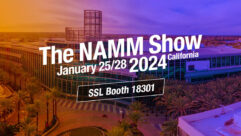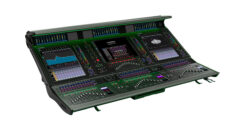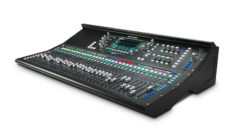
Technology Showcase: Analog Consoles
Oct 1, 2004 12:00 PM,
By Bruce Borgerson
Soundcraft LX7ii
“The rumors of my death have been greatly exaggerated,”
said Mark Twain in an epigram that could just as well apply to analog
mixing consoles.
Although digital technology now largely dominates audio recording
and signal processing, the bulk of the mixing console market —
for live sound applications in particular — remains firmly
planted in the analog domain. Thus far the greatest relative
penetration of digital consoles has been into high-end touring and
Broadway-style theater applications, in which the appealing option of
resetting everything — effects, dynamics, EQ, and mutes —
for best results on every song can be easily accommodated with the push
of a button. That ultimate level of programmability, along with lower
weight and a far smaller footprint per input channel, makes digital
consoles worth the extra cost and extended learning time in such
particularly demanding situations.
In other areas, however, analog consoles continue to hold the edge.
Certainly you can get more inputs and outputs per dollar with analog.
Many would argue that, given equivalent R&D funds, a skilled analog
console designer still can come up with better overall audio
performance. But in the end, analog’s trump card still seems to be that
comfortingly familiar work surface with its rows of dedicated knobs and
switches: one control for one function, always at your fingertips.
ANALOG TRENDS
Because it’s a mature technology, don’t expect anything dramatically
new. In fact, if any trend could be identified, it could be summarized
as “more of the same for less” or “the advance of
trickle-down technology.” Essentially, customization of consoles
is a thing of the past, except for small concessions at the high end.
To accommodate the efficiencies of mass manufacturing, console makers
are simply packing in more features at ever-lower price points, whether
you need them all or not.

One clearly identifiable trend is toward dual-function (also known
as “swap or “flip” mode) consoles that can switch
from front-of-house (FOH) to monitor duty by assigning aux sends to the
group faders. Piggybacking on that trend, in midrange consoles on up,
is the increasing availability of facilities to accommodate in-ear
monitoring: paired sends switchable for stereo, inserts for protective
dynamics processors, and room ambience inputs. Such flexible facilities
— coupled with the rapid penetration of digital into the high-end
monitor market — may signal the early demise of dedicated monitor
consoles.
Otherwise, the overall trends reflect steady downward migration of
features and technologies into ever-lower price regions:
voltage-controlled amplifier (VCA) groups, programmable scene mutes
with MIDI and external computer control, parametric equalizers,
built-in dynamics, external linking facilities, and perhaps most
dramatically, more inputs per dollar. One trend just now peeking over
the horizon is the predictable emergence of digital interfaces: five
major console manufacturers have licensed CobraNet technology, and
Mackie’s recording-oriented FireWire option in its new budget mixers
may be a harbinger of what’s to come.
In the following summaries, consoles are lumped into three price
groups with somewhat arbitrary boundaries: budget ($1,200 to $6,000),
midline ($6,000 to $40,000), and high end ($40,000 and up). Except as
noted, prices are MSRP; these figures should be seen as broad
guidelines only and are, of course, subject to change. Because covering
all analog consoles in even skimpy detail is impossible, discussion
will be weighted toward more recent product introductions. Powered
mixers, BGM/paging mixers, and dedicated monitor consoles are not
included.
ALLEN AND HEATH
This venerable U.K. console maker regained its independence three
years ago, after nearly a decade of ownership by Harman International.
Released from the possible constraints of dovetailing with a sibling
company (Soundcraft), Allen and Heath now is blanketing its target
markets with product offerings ranging from sub-$1,000 MixWizards up
through the fully loaded flagship $25,000-plus ML5000, and the company
has staked out a healthy share of it.

Allen and Heath ML5000
For nearly a decade, the company mainstay has been the widely
accepted GL Series, ranging from the nicely featured but few-frills
GL2200 (16-, 24-, and 32-input frames) up to the enhanced GL4000 (24-,
32-, 40-, and 48-input frames) with its eight audio groups, automated
scene muting with eight mute groups, balanced inserts, and
sophisticated pre/postfader listen facilities. Combining a solid build
with prices starting at less than $3,000, the GL2200 staked out the
lower end of the school and church markets, and the GL3300 and GL4000
moved up into larger worship auditorium, club, and corporate
applications.
But the GL boards were lacking features that have since become
essential for more sophisticated production applications, primarily LCR
panning and VCA groups. Allen and Heath remedied that deficiency with
the introduction of the ML line, which is broken down into three series
(ML3000, ML4000, and ML5000) distinguished primarily by the number of
audio groups, aux sends, and matrix outputs available. In addition to
the standard LCR panning and VCA groups (eight available), all ML
Series boards are dual mode and equipped with 128 snapshot memories,
eight mute groups, and comprehensive channel EQ, including variable
highpass filter and variable Q on the two midrange bands. The
microprocessor-controlled mute and VCA functions are accessible via
MIDI or external Windows computer.
With 24-, 32-, and 40-input frames offered at prices in the $6,000
to $10,000 range, the ML3000 is aimed squarely at the sweet spot of the
lower midline market. It has only four audio groups (as opposed to
eight on the 4000 and 5000 series), but the eight aux sends and the
8-by-4 matrix offer sufficient flexibility to cover a broad swath of
moderately demanding applications.
ATI
Audio Toys (ATI) is the U.S. distributor of two high-end live sound
consoles, the U.S.-made Paragon and the British-made Audient Aztek.
As the name implies, Paragon is a no-holds-barred, premium analog
board designed for very high-performance applications in touring or
performing-arts venues. Fully modular and essentially hand-built, the
Paragon Production II model offers patented dynamics processing
circuitry on every channel (including fully parametric gates), moving
fader options, and the capability of creating four audio LCR subgroups.
Balanced buses and high-voltage rails assure premium audio specs for
those who are willing to pay the price — starting at about
$120,000.
For those who want a fully modular, touring-friendly console at
about half the cost, the Audient Aztek is worthy of notice. Also a
fully modular design, the Aztek is distinguished by its external
tubular aluminum frame. With prices starting around $50,000, the Aztek
comes equipped with sophisticated parametric EQ facilities, 12 each of
both aux sends and VCA groups, a 12-by-8 matrix, and a stereo ambience
input for use with in-ear monitors.
CADAC

Cadac S-Type
Justifiably known as the Rolls-Royce of console makers, Cadac has
cornered a secure share of the high-end analog market by concentrating
on exceptional audio quality and features important to its core
clientele, which is historically the elite of the theater market.
Recently, however, Cadac has stepped down a notch in size and feature
sets — though, it insists, not on quality — to serve the
needs of smaller venues and the corporate AV market. With prices
starting at a modest (for Cadac) $25,000, the new S-Type comes in 12-,
16-, and 24-input frames, each equipped with 100 mm P&G faders.
Unlike nearly all other compact mixers, the S-Type is fully modular,
allowing custom configuration with different mono, stereo, and master
module options. For many applications requiring exemplary audio quality
in a small footprint, it’s worth the extra money to “have it your
way.”
CREST
Years following the much-ballyhooed corporate acquisition by Peavey,
Crest has retained both its own identity and New Jersey manufacturing
facility. The company maintains a broad line of console products,
though in recent years, Crest has been shifting resources lower in the
market. Sales of the flagship V12 have been damped by fierce
competition from both analog and digital consoles, as well as slow
market growth at the high end. As a consequence, Crest is turning to
the greener pastures of the burgeoning upper-budget and midline
markets.

Crest HP-Eight
At the upper end of the midline, Crest pioneered the concept of
bringing high-end features to a lower price point with its X-VCA.
Starting at less than $20,000, the X-VCA offers not only VCA groups and
microprocessor/MIDI mute groups but also LCR panning, and — still
an exclusive in this price category — built-in dynamics
processing on each input. The balance of the X Series fills in the rest
of the midline and carries down into the budget category. The X-Four
and X-Eight Series boards offer a variety of frame sizes, rackmount
versions, and dedicated monitor configurations.
In an effort to open a lead in the “more for less”
competition, Crest’s new HP-Eight is loaded with some features not
previously seen in the lower price group. A dual-function board made in
the United States, the HP-Eight boasts eight audio subgroups, ten aux
sends (with two pairs switchable for stereo operation in Monitor mode),
100 mm faders, 4-band EQ with two swept mid-bands, and four scene mute
groups. The master module includes five stereo inputs, and mono inputs
can be added in blocks of eight for frame sizes from 24 to a whopping
56 inputs. With prices starting at $3,600 and topping out at $5,900,
the HP-Eight makes sense when basic features, sturdy build, and a lot
of inputs take precedence over more advanced (and presumably unneeded)
feature sets.
MACKIE
Beginning with the fabled Tapcos of the early ’70s, mixers designed
by Greg Mackie have garnered a reputation for screaming-is-no-problem
headroom, savvy features, and solid construction. The self-named
company he founded in the late ’80s has gone through a number of
changes, but Mackie bloodlines remain evident across the product
range.

Mackie Onyx 1640
The earliest mixers from Mackie were smaller, multipurpose units
tilted more toward recording than P.A., though they found their way
into countless live sound applications. Responding to the particular
needs of live production, Mackie later introduced its dedicated SR line
of mixers in both 4- and 8-bus versions. The 8-bus and larger frame
sizes have since been discontinued, but Mackie continues to offer both
the midbudget SR32-4 and SR24-4 models, starting at about $1,700. These
well-built and stylish mixers offer Mackie’s proprietary
high-headroom/low-noise XDR mic preamps, 3-band EQ with swept mids
(four band fixed on stereo channels), six aux sends (two prefader, two
postfader, two switchable), and summed mono output.
Mackie’s new Onyx line of mixers is worthy of note, though you have
to look at the top-of-the line 4-bus 1640 to boost yourself out of the
“sub-budget” (less than $1,200) category. Listing at about
$1,500, this worthy successor to the legendary 1604 series mixers
offers similar features but upgraded technology, including new mic
preamps, 4-band EQ with sweepable mids, six aux sends with individual
pre/postfader switching, talkback section, and the familiar rotating
I/O pod for desktop or rackmount use. For another $500, you can add
FireWire I/O, which could prove handy in applications in which
simultaneous digital hard-disk recording is desired.
Just announced for shipping in mid-2005 is the Onyx 80 Series with
24-, 32-, 40-, and 48-channel versions.
MIDAS
Although merged into the U.S.-based Telex group at the corporate
level, Midas has maintained its image as a solidly British enterprise.
The company is now leveraging its sterling reputation as a high-end
touring supplier into an expanding slice of the midline installation
market, with an early foray down into the budget regions, as well.
Midas is still best known for consoles like the high-priced,
heavyweight XL4, back by popular demand, and its successor-in-waiting,
the Heritage 4000. Both are packed with a plethora of high-end
features: full parametric equalization, motorized VCA faders, powerful
dynamic and snapshot automation, and sonically pristine mic preamps. If
prices starting well over $150,000 are too steep, Midas still satisfies
most big-name tour tech riders with its Heritage 3000, which manages to
cut the price tag essentially in half. The next step down, appealing to
regional sound companies and upper-end installations, is the Legend
3000. Semimodular design further trims the cost ($32,000 to $44,000),
but the Legend retains key features like the XL4 preamp circuitry, XL3
equalizers, and a full complement of 12 aux sends.
However, the big news for the installation market is the
“Italian cities” series, which launched a few years ago
with the Venice. This daring entry into the high-quality, compact 4-bus
market is offered in 16-, 24-, and 32-input frames selling in the
$3,000 to $5,000 range. Although the feature set (four stereo inputs,
six aux sends, and 4-band EQ with swept mids) is hardly exceptional at
the price point, the attention to sonic detail and the trademark Midas
work surface (with its multicolor screenings) have lifted the Venice
just above the crowded field jostling below it.
With the Verona, Midas is making a strong push into the upper
midline. Nestled between the Legend and Venice, with list prices
ranging from about $11,000 to $24,000, the Verona comes in six frame
sizes (24 to 64) inputs in banks of eight, with each including a bank
of eight green-fadered stereo “multipurpose” inputs. Midas
apparently made a conscious decision not to “down-market”
its VCA control, as many competitors have done, perhaps assuming (with
justification) that many users at this level don’t use it or misuse it.
Instead, the Verona focuses on the proven company strengths: excellent
audio quality, easy-to-navigate work surface, solid build, and flexible
circuit architecture. Along with eight each group and aux buses, the
Verona offers group inserts, LCR panning with the proprietary Spatial
Imaging System, a 12-by-4 matrix, 4-band sweepable EQ, and a dual
redundant power supply on the larger frame sizes.
PEAVEY
The purchase of Crest by Peavey has not, as some had speculated,
resulted in a wholesale merger of the two console lines. Rather, Peavey
has retained its own branding on low to midlevel budget mixers, ceding
only the midline and upper market to Crest. The main Peavey brand goes
through MI outlets, and the Architectural Acoustics division
distributes a limited range of mono/stereo and 4-bus mixers in the
$1,200 to $3,000 price range. At the top of this line is the AAM 3243,
which features 32 mono inputs, four group buses, sweepable midband EQ
with variable low-cut filter, and six aux sends. A distinct feature is
the availability of soft-knee compressors on each group bus, linkable
for stereo operation and patchable through inserts into any input
channel.
The Peavey formula for success is based on developing product
features that appeal to a broad but well-defined market and then
marketing that product at a highly competitive price point. Case in
point: the Sanctuary S-14 and S-24. Targeted at churches with
nontechnical operators (or no operators at all), the S-14 and S-24
feature four channels of automatic microphone mixing, built-in
compression on both the automix channels and music groups, proprietary
Feedback Ferret autosensing notch filters, and a novel midmorph EQ that
cuts low-mids (to remove muddiness) or boosts mid-highs for added vocal
presence. These uncommon features may prove initially confusing to some
audio novices, but Peavey assumes that quick mastery is possible, and
after that it’s clear sailing. If the Peavey hunch is right (again), at
a list price of $1,200 and $1999.99 respectively, the S-14 and S-24
could sell by the truckload.
SOUNDCRAFT
While Allen and Heath was tucked under the same corporate umbrella,
Soundcraft seemed to concentrate more on high-end touring, recording,
and broadcast applications while at the same time creating a separate
identity — Spirit — for the budget-oriented line. Recently,
however, the company has made several notable midline introductions,
and the Soundcraft logo is starting to reclaim the upper budget lines
from the Spirit moniker.

Soundcraft LX7ii
Soundcraft retains a firm foothold in the sub-$100,000 high-end
market with its Series Five desks, and the newer MH4 multipurpose desk
bridges into the midline with sophisticated production features (16 aux
buses, 20-by-4 matrix, VCA groups, automation, and so on) at prices
from $24,000 to $48,000. From there it was a big step down to the K3
theater, which sported a far more limited feature set but was tagged
with prices starting at less than $13,000. That left a niche to be
filled, and Soundcraft has plugged it nicely with the new MH3.
Also a dual-purpose FOH/monitor desk, the MH3 comes in frame sizes
from 24 to 56 mono inputs, with four stereo inputs standard. Eight
group buses are available for FOH mode, and the 12 aux buses allow 12
mono mixes (or 8 mono and 2 stereo) in Monitor mode. Other attractive
features include eight mute groups and eight VCA groups, snapshot
automation, LCR panning, and 12-by-4 matrix expandable to 12-by-8 with
optional module. Prices start at less than $16,000 and go up to about
$26,000 for the 56-input frame.
For budget applications, there’s the brand new LX7ii, now marketed
under the Soundcraft name. (The first LX7 carried the Spirit logo.)
Although still in the budget category ($1,800 for 24 inputs, $2,500 for
32), this upgraded version shows mettle worthy of the parent company
name. A new preamp design claims improved performance, and the 4-band
EQ with sweepable mids is based on the MH3/MH4 circuitry. The 7-bus
design includes four groups as well as stereo and dedicated mono/center
main outputs.
YAMAHA

Yamaha PM5000










